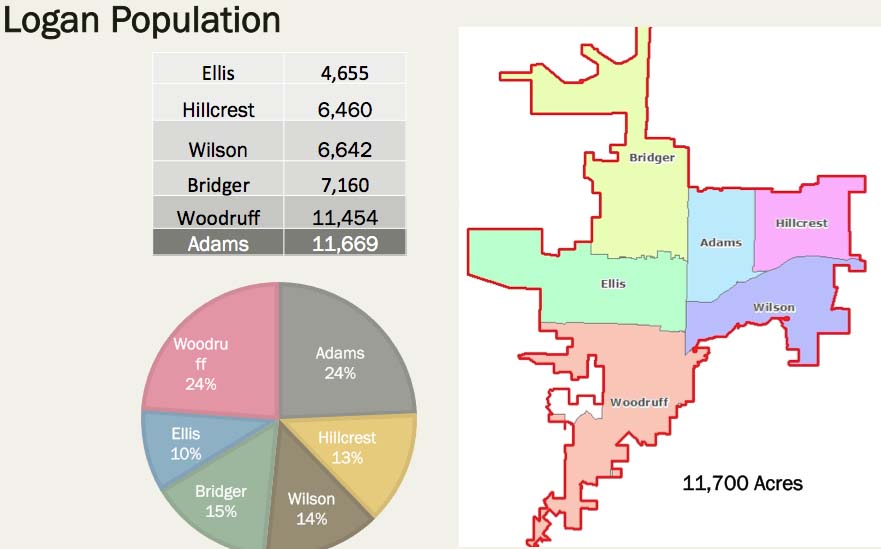LOGAN – A scholarly presentation Tuesday by a political scientist to the Logan City Council is drawing fire from a committee of neighbor representatives.
At the request of council chair Mark Anderson, Utah State University political science professor Damon Cann discussed the pros and cons of alternative schemes for municipal voter representation. That invitation came after a committee of neighborhood representatives recommended in January that Logan convert its at-large city council members into representatives of city voting districts.
Woodruff neighborhood representative Keegan Garrity viewed Cann’s council presentation as old news, however, since it differed little from a similar presentation that the professor delivered to members of the citizens committee in August of 2020.
“Why was Prof. Cann once again invited (by council members) to present and answer questions on this topic?” he argued. “But members of the committee – and residents of their own city – were not?
“Are these voices not equally important? It’s not hard to see why people don’t feel that they are represented.”
In October 2019, the Logan City Council agreed to form a citizen committee to evaluate voting systems following a contentious meeting during which former city council member Jess Bradfield urged that panel to voluntarily adopt an ordinance implementing by-district election of council members.
As designated by former city council chair Amy Z. Anderson, the citizen committee’s charter was to examine the council’s current representation history, make comparisons to peer cities, identify pros and cons of a change in election process, investigate the legality of any election process change and seek consensus and/or minority opinions on the proposed change.
In January, the committee submitted a report urging a shift to a voter district system for the city council, noting that five of its six members believed that change would facilitate broader and more diverse representation on the city council.
“Prof. Cann’s presentation was one of many components the committee considered during its deliberations,” Garrity explained. “The general information he provided was applied to specific outcomes and demographics in our own city as part of a thorough investigation. After 11 months of intense scrutiny, five of the six neighborhood representatives determined that the pros (of by-district representation) outweigh the cons.”
For his part, Cann was actually highly complimentary of the efforts by the citizens committee.
“I had a really great conversation with that group,” he explained. “They asked great questions and I think they were really trying hard to do the best they could they could to evaluate the question…of using district-based elections as opposed to at-large voting. I want to give a shout-out and kudos to them for their effort and engagement on this issue.”
But Cann said there’s no simple answer to the question of whether district-based voting or at-large voting produces the best representation for a municipality. He based that cautious approach not only on his academic study of political theory, but also on personal experience as a member of the North Logan City Council and as mayor of that community.
“It’s a tough issue,” he acknowledged. “If you’re looking that this issue right now and think that the answer is easy – that ‘we should definitely do x’ – then you probably haven’t thought about the issue enough. If you’re uncertain about this question, that’s probably a healthy place to be.”
Cann said the complexity of that issue is illustrated by the fact that, of Utah’s 20 largest cities, eight of them use at-large systems, another eight use by-district voting and the last four use a mix of at-large and district-based seats on their city councils.
The City of Provo, for example, recently switched to such a hybrid system for their city council.
From the sidelines of the debate over voter representation in Logan, Bradfield (who now serves as Cache County Clerk) suggested that the answer to a single question could help to clarify the discussion.
“Why,” he asked, “are there no cities transitioning to at-large representation, but dozens changing to by-district or mixed representation?”
To justify their certainty about the need for change, the majority of the citizen committee members noted that candidates from two of the city’s six neighborhoods – Hillcrest and Wilson – have dominated the city council since at-large representation was implemented in 2009. The committee members noted that those two neighborhoods are the city’s wealthiest and least diverse areas. They also have Logan’s highest percentage of owner-occupied housing.
But Cann cautioned that simply making a shift to by-district representation isn’t likely to resolve underlying issues of civic engagement and voter participation.
“While institutional change can give a nudge in one direction or the other,” he said, “solving problems of engagement and participation is not as simple as choosing at-large or district elections. Engaging voters in these (under-represented) areas of the city will depend on extensive outreach efforts from civic-minded candidates, elected officials and neighborhood activists more than anything else.”
While members of the city council pledged to give Cann’s presentation due thought, Garrity dismissed those promises as delaying tactics.
“Clearly, (our report) has not been a priority and why would it be?” he asked. “There is little incentive to change a system in which you are the benefactor.
“If any member of the council wants to debate this issue, I would be willing to participate,” Garrity added. “I suspect that will never take place, because it’s easier to suppress an alternative point of view than it is to come up with a superior argument.”

